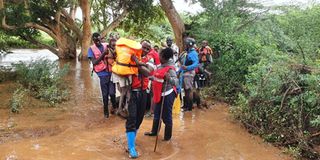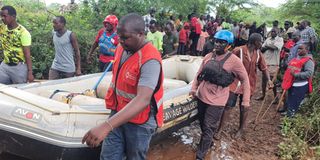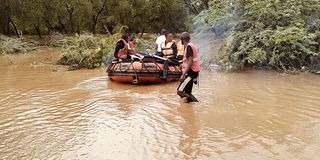Premium
Endless cycle of displacement of Baringo families with nowhere to go

A total of 220 families from the village reside at the camps after their homes were swallowed by floods following the recent heavy rainfall.
What you need to know:
- “I have been displaced eight times since 2012, but do I have a choice? I am forced to become an internally displaced person every year.” - Florence Lekurle, 30, Longewan village, Baringo South.
- This is not, however, the first time Longewan villagers have found themselves in a displaced persons camp following floods. They have been displaced over the years, and have become adept at a lifestyle of hopping from their homes to displacement camps during rainy seasons. The cycle keeps repeating itself.
Florence Lekurle, 30, sat pensively on the floor of a classroom at Logumgum Primary School, where she and her Longewan village mates in Baringo South sought refuge after being displaced from their homes by floods a month ago.
Her sick daughter, who was beset by flu occasioned by the cold snap at the camp lay slept on the floor, waking up at intervals to sip some water to ease frequent coughing.
Like the rest of the villagers, Ms Lekurle’s greatest predicament is how to resettle her family again after normalcy returns.
A total of 220 families from the village reside at the camps after their homes were swallowed by floods following the recent heavy rainfall.
With the help of the Kenya Red Cross, the inhabitants of Longewan were evacuated by boat after their homes were marooned by flood water that also submerged roads, paralysing transport in the area.

Officials from the Kenya Red Cross evacuating families marooned by flooding in Longewan village in Baringo South on May 4, 2024.
The villages adjacent to Lake Baringo were marooned in water after Rivers Molo and Perkerra broke their banks, leading to the displacement of thousands of people in Longewan, Leswa, Rine, Sintaan, Eldume, Ilpunyaki, Kabikoki, Loitip, Sororwa, Losampurmpur, Sirata, Lorok, Eltepes and Nereteti villages.
The mother of five suffered untold loss after her house, farm, and livestock were swept downstream by the floods.
“I lost everything, save for a few clothes that I salvaged. I am now a pauper, with nowhere to call home because all my property is submerged,” she said.
She is among the displaced families at the camp waiting for the water to recede before returning to her village to start over, again. The village is currently inaccessible.
This is not, however, the first time Longewan villagers have found themselves in a displaced persons camp following floods. They have been displaced over the years, and have become adept at a lifestyle of hopping from their homes to displacement camps during rainy seasons. The cycle keeps repeating itself.
They say they have nowhere else to go and plod back to their homes after every rain-filled year when things get drier and back to the camps whenever the floods come calling.
Ms Lekurle has been displaced by perennial flooding eight times since 2012, and every time she and her dependants seek refuge in safer places until the floods recede and homeground declared safe again to reclaim and start over again.
“I have been displaced by the floods eight times but do I have a choice? Whenever the waters recede, I go back to the same village and start over again because I don’t have an alternative destination. I am forced to become an internally displaced person every year when heavy rains fall,” she told Nation.Africa.
The villagers who have been affected by floods over the years appealed to the government to provide them with an alternative place to build new homes, to save them from the agony of having to hop from flooded homes to displacement camps over and over again whenever seasons change.
“Our woes will only end if the government provides us with an alternative land to build because I cannot afford to buy land elsewhere. If not, we will just continue suffering and move every year the rains come down,” said Ms Lekurle.
Also, in the same predicament is Jackline Koyala, 40, one of more than 100 households who relocated to Uwanja Ndege village on the outskirts of the flood-prone Ng’ambo and Loropil villages in Baringo South after rising water levels at Lake Baringo swallowed their homes and farms, pushing them out of their homes.
Ms Koyala has been on the move since 2010 when floods pushed her way from Maasai village adjacent to the lake. She has sired five of her seven children while living in temporary camps
“This is my fifth time being displaced by floods. I first moved from my home in 2010 when River Perkerra burst its banks submerging most homes, forcing us to relocate to safer areas. I have however been on the move since then,” said Ms Koyala.
Like the rest, she too waits until the rains stop before trooping back and start over again.
“We’ve been hit by floods over the years but never to the extent of displacing thousands of people bordering the Lake. I helplessly watched as my house was being swallowed by the rising water levels. I did not manage to salvage anything save for a few utensils and a tattered tent that I was given by the Kenya Red Cross in 2017, but other belongings were swept downstream,” the distraught mother told Nation.Africa while at the displacement camp.
Ms Koyala is among hundreds of households that benefitted from a project by the Kenya Red Cross that helped rebuild new houses for vulnerable flood victims in 2018. However, the blessing was short-lived as the house was swallowed this year and is now two kilometers inside the Lake.
Ms Mary Kirati, a flood victim over the years from Noosukro village, complained that they have been displaced by floods over the years but little has been done by the government to end their perennial suffering.
“We have suffered in the displacement camps. Our children contract cold-related diseases due to the biting cold. Expectant women give birth in the shanty shelters, posing a health risk to the newborns,” said Ms Kirati.
“We are tired of moving every year when it rains. We need alternative land from the government to settle as a lasting solution,” she said.
In the recent flooding, several schools like Eldume, Salabani, Longewan, Leswa, Sintaan, Loldama, Kapikoki, and Lemayana primary schools were swallowed by water.
Hundreds of acres of crops under irrigation were swept away by raging floods after Rivers Perkerra, Waseges, and Molo burst their banks following the heavy rainfall.
Irrigation schemes that were affected were Perkerra, Murda, Wasu, Nenteyo, Ilpunyaki, Lorrok, Sandai, Mosuro, Eldume, Kamosok and Sukutek.
According to the Kenya Red Cross, more than 10,000 people in Baringo County were displaced, with the worst hit being Baringo South and parts of Mogotio sub-counties.
Villages that were affected are on lowlands and have been hit by floods over the years as rainwater from the highland areas flows down to them.

With the help of the Kenya Red Cross, the inhabitants of Longewan were evacuated by boat after their homes were marooned by flood water that also submerged roads, paralysing transport in the area.
In 2020 for instance, Lake Baringo increased from 236 km2 in 2015 to approximately 278 km2, posing a threat to adjacent villages. The drastic rise in water levels saw more than 1,000 houses at the shores of the water mass submerged.
Among the worst-hit villages are Loruk, Noosukro, Kokwa Island, Kampi Samaki, Sokotei, Lorok, Kiserian, Ruggus, Loitip, Mukutani Ndogo, Ng’ambo, Sintaan, Salabani, Ilng’arua and Longeiwan.
The phenomenon forced more than 10,000 people to seek refuge in temporary camps in safer villages after their houses were completely swallowed by the Lake waters.





